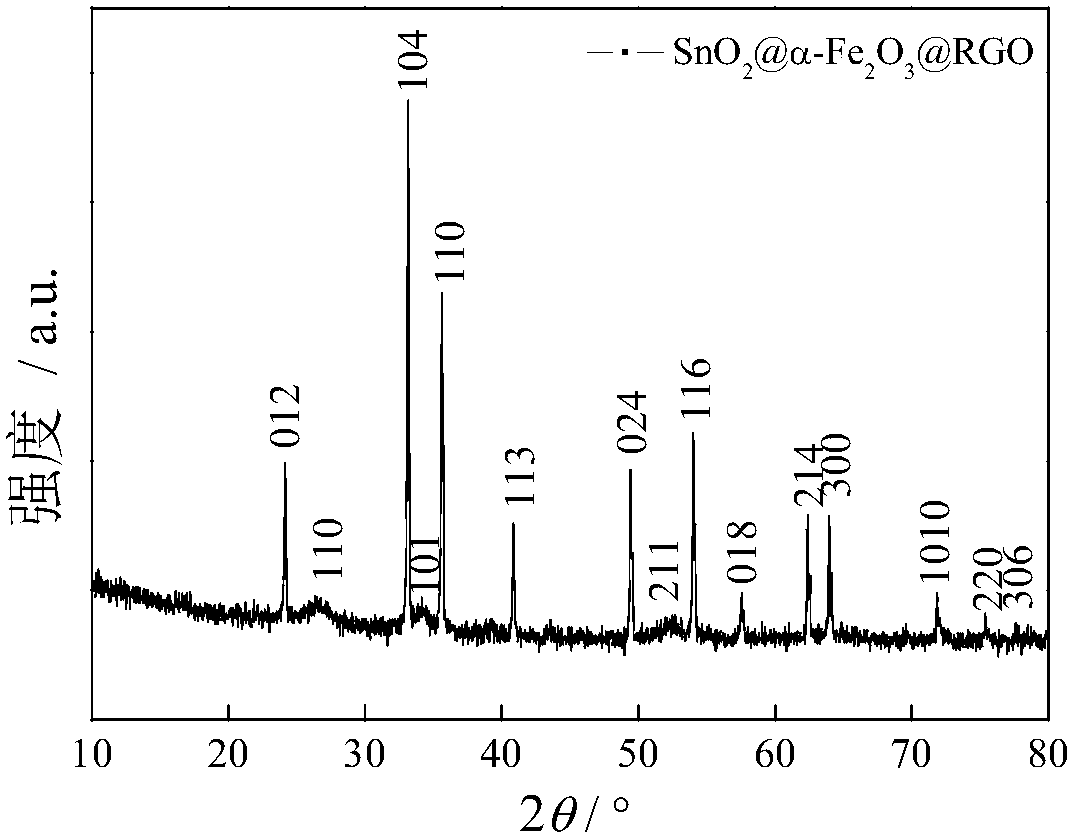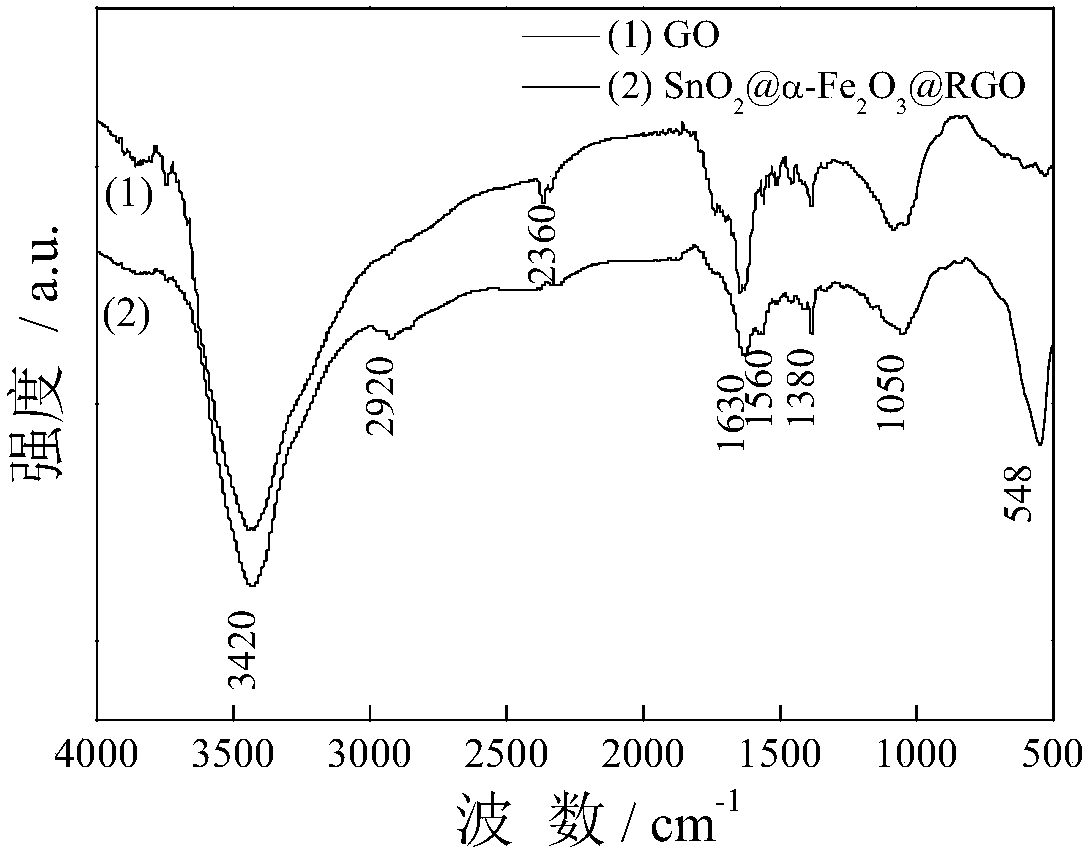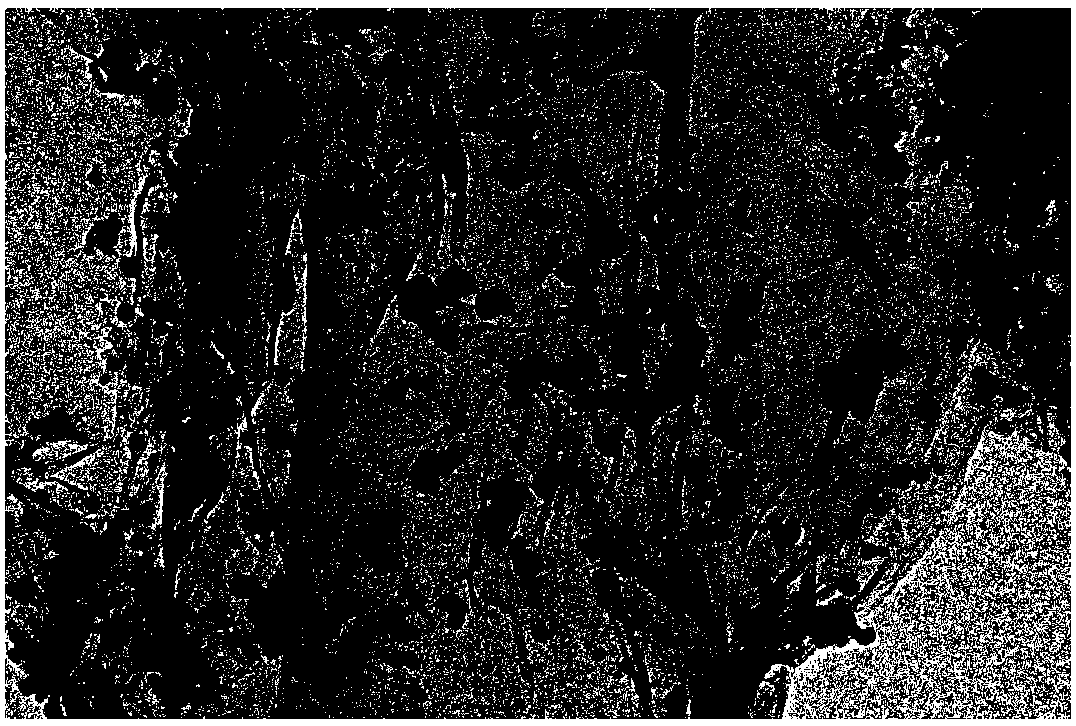Reduced graphene oxide, tin dioxide and ferric oxide composites
A technology of ferric oxide and tin dioxide, applied in chemical instruments and methods, other chemical processes, electrical components, etc., can solve problems such as poor thermal stability and high density, and achieve promotion of peeling, low density, microwave absorption performance Improved effect
- Summary
- Abstract
- Description
- Claims
- Application Information
AI Technical Summary
Problems solved by technology
Method used
Image
Examples
Embodiment 1
[0032] The composite material of reduced graphene oxide, tin dioxide and iron trioxide of the present invention is prepared according to the following method, including the steps:
[0033] (1) Preparation of graphene oxide
[0034] Add 3.0g of natural graphite powder and 25g of potassium permanganate into the beaker, mix well and slowly add 200mL of concentrated sulfuric acid and 20mL of phosphoric acid; stir well, put it in an oil bath, and stir at 70°C for 18 hours; After cooling to room temperature, slowly pour the above mixed solution into a plastic beaker containing 400 mL of ice, add 5 mL of hydrogen peroxide dropwise, the solution turns bright yellow to obtain a graphene oxide solution; use dilute hydrochloric acid for the graphene oxide solution It is washed, then washed with absolute ethanol to near neutrality, and dried under vacuum at 40° C. for 18 hours to obtain graphene oxide powder.
[0035] (2) Preparation of microwave absorbing materials for reduced graphene oxide, ...
Embodiment 2
[0038] (1) Preparation of graphene oxide
[0039] Add 3.0g of natural graphite powder and 18g of potassium permanganate into the beaker, mix well and slowly add 450mL of concentrated sulfuric acid and 30mL of phosphoric acid; stir well, put it in an oil bath, and stir for 24 hours at 50°C; After cooling to room temperature, slowly pour the above mixed solution into a plastic beaker containing 400 mL of ice, add 10 mL of hydrogen peroxide dropwise, the solution turns bright yellow to obtain a graphene oxide solution; use dilute hydrochloric acid for the graphene oxide solution It is washed, then washed with absolute ethanol to near neutrality, and dried under vacuum at 40° C. for 18 hours to obtain graphene oxide powder.
[0040] (2) Preparation of microwave absorbing materials for reduced graphene oxide, tin dioxide and iron trioxide
[0041] Add 80 mg of graphene oxide to a mixed solution of 20 mL of ethanol and 50 mL of deionized water, disperse ultrasonically for 1 hour, then add...
Embodiment 3
[0043] (1) Preparation of graphene oxide
[0044] Add 3.0g natural graphite powder and 18g potassium permanganate into the beaker, mix well and slowly add 150mL concentrated sulfuric acid and 10mL phosphoric acid; stir well, put it in an oil bath, and stir at 80℃ for 12 hours; After cooling to room temperature, slowly pour the above mixed solution into a plastic beaker containing 400 mL of ice, add 5 mL of hydrogen peroxide dropwise, the solution turns bright yellow to obtain a graphene oxide solution; use dilute hydrochloric acid for the graphene oxide solution It is washed, then washed with absolute ethanol to near neutrality, and dried under vacuum at 40° C. for 18 hours to obtain graphene oxide powder.
[0045] (2) Preparation of microwave absorbing materials for reduced graphene oxide, tin dioxide and iron trioxide
[0046] Add 20mg of graphene oxide into a mixed solution of 20mL ethanol and 50mL deionized water, and disperse ultrasonically for 1 hour, then add 0.5406g ferric c...
PUM
| Property | Measurement | Unit |
|---|---|---|
| particle diameter | aaaaa | aaaaa |
| particle diameter | aaaaa | aaaaa |
| coating thickness | aaaaa | aaaaa |
Abstract
Description
Claims
Application Information
 Login to View More
Login to View More - R&D
- Intellectual Property
- Life Sciences
- Materials
- Tech Scout
- Unparalleled Data Quality
- Higher Quality Content
- 60% Fewer Hallucinations
Browse by: Latest US Patents, China's latest patents, Technical Efficacy Thesaurus, Application Domain, Technology Topic, Popular Technical Reports.
© 2025 PatSnap. All rights reserved.Legal|Privacy policy|Modern Slavery Act Transparency Statement|Sitemap|About US| Contact US: help@patsnap.com



